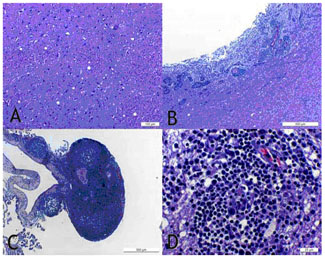Animal Science

Prion form atypical scrapie lacks lymphotropism
From the active TSE surveillance programme in Catalonia, the Priocat laboratory of animal health research centre (CReSA) has detected a noticeable lack of lymphotropsim as far as scrapie-associated prion protein deposition is concerned. Results described in the paper, where a viral encephalitis -which implies formation of lymphoid follicles in the brain- is concomitant to a prion disease. In the classical strains the prions show a strong affinity for the lymphoid tissue but not in this case, even when follicles are as close as in the same brain.
References
Lack of PrPsc immunostaining in intracranial ectopic lymphoid follicles in a sheep with concomitant non-suppurative encephalitis and Nor98-like atypical scrapie: A case report.Vidal, E; Tortosa, R; Costa, C; Benavides, J; Francino, O; Sanchez-Robert, E; Perez, N; Pumarola, M.VETERINARY JOURNAL, 177 (2): 283-288 AUG 2008
An initial reactor was obtained with a transmissible spongiform encephalopathy (TSE) rapid test from an ovine brain sample. After that, through immunohistochemistry confirmed an atypical TSE presentation in that sample closely resembling the previously described Nor 98 cases.
Sequencing of the prnp gene confirmed the presence of the L141F mutation associated with this phenotype. The head, including the brain and cranial lymphoid tissues, was sampled and thoroughly studied. Non-purulent encephalitis, with ectopic lymphoid follicle formation within the brain, was diagnosed concomitant to the TSE. When scrapie-associated prion protein (PrPsc) deposition was studied by immunohistochemistry, a noticeable lack of lymphotropism was evidenced. Brain distribution of PrPsc differed considerably from that of classical scrapie cases.
Astrogliosis and microgliosis were evidenced by histochemical procedures. Other markers, such as cleaved caspase 3, perineuronal nets and gabaergic neural populations, were also evaluated and remained unchanged compared to control animals.
Enric Vidal, R. Tortosa, C. Costa, J. Benavides, O. Francino, E. Sanchez-Robert, N. Pérez i M. Pumarola
Centre for Research in Animal Health (CRESA)
Department of Animal and Food Science
Universitat Autònoma de Barcelona
2024 Universitat Autònoma de Barcelona
B.11870-2012 ISSN: 2014-6388
